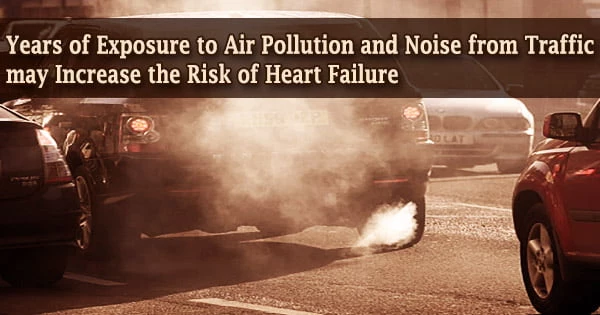According to new research published today in the Journal of the American Heart Association, an open-access journal of the American Heart Association, long-term exposure to air pollution and road traffic noise may be linked to an increased risk of developing heart failure, and the link appears to be even stronger in people who are former smokers or have high blood pressure.
“We found that long-term exposure to specific air pollutants and road traffic noise increased the risk of incident heart failure, especially for former smokers or people with hypertension, so preventive and educational measures are necessary,” said Youn-Hee Lim, Ph.D., lead author of the study and assistant professor in the section of environmental health within the Department of Public Health at the University of Copenhagen in Copenhagen, Denmark.
“To minimize the impact of these exposures, broad public tactics such as emissions control measures should be implemented. Strategies like smoking cessation and blood pressure control must be encouraged to help reduce individual risk.”
Over a 15-to-20-year period, this study looked at the effect of long-term environmental exposure, especially from air pollution and road traffic noise, on the development of heart failure in a cohort of female nurses in Denmark.
Researchers used data from the all-female Danish Nurse Cohort research, which included approximately 22,000 participants. The ladies were 44 years old or older when they enrolled in the research and lived in Denmark.
We found that long-term exposure to specific air pollutants and road traffic noise increased the risk of incident heart failure, especially for former smokers or people with hypertension, so preventive and educational measures are necessary.
Youn-Hee Lim
Participants were enrolled in 1993 or 1999 and were asked to fill out a detailed questionnaire on their BMI, lifestyle variables (smoking, alcohol use, physical activity, and dietary habits), pre-existing health issues, reproductive health, and employment conditions.
Throughout the 20-year research, data on heart failure diagnoses was acquired by connecting study participants to the Danish National Patient Register, which contains records on all health care delivered in Danish hospitals. Data on patients was gathered till December 31, 2014.
The participants in the research resided in rural, urban, and suburban locations across Denmark. Between 1970 and 2014, researchers kept records of each individual’s residential locations, including any movements to new houses, in order to better evaluate individual exposure to air pollution and road traffic noise.
The yearly average concentrations of two components, fine particulate matter (PM2.5) and nitrogen dioxide (NO2), were measured using a Danish air pollution modeling system to assess levels of air pollution. Road traffic noise levels were assessed using a validated model system called Nord2000 and quantified in decibels (dB), the standard measurement for the intensity of sound, within a three-kilometer radius of the participants’ home addresses.
The analysis of various pollutants and their effects on incident heart failure found:
- The risk of incident heart failure increased by 17 percent for every 5.1 g/m3 increase in fine particulate matter exposure over three years;
- For every 8.6 g/m3 increase in NO2 exposure over three years, the risk of incident heart failure increased by 10%;
- For every 9.3 dB increase in road traffic noise exposure over three years, the risk of incident heart failure increased by 12 percent; and,
- A 72 percent greater risk of incident heart failure was linked to increasing exposure to fine particulate matter and status as a former smoker.
“We were surprised by how two environmental factors air pollution and road traffic noise interacted,” Lim said. “Air pollution was a stronger contributor to heart failure incidence compared to road traffic noise; however, the women exposed to both high levels of air pollution and road traffic noise showed the highest increase in heart failure risk. In addition, about 12% of the total study participants had hypertension at enrollment of the study. However, 30% of the nurses with heart failure incidence had a previous history of hypertension, and they were the most susceptible population to air pollution exposure.”
The study includes a number of flaws. Additional variables that could have influenced the findings of the study included measures of each individual’s exposure to indoor air pollution or occupational noise, the amount of time spent outdoors, the thickness of their home’s windows, which could influence noise pollution levels, whether they had a hearing impairment, and their individual socioeconomic status.
Furthermore, nearly a quarter of the initial participants in the Danish Nurse Cohort were eliminated from the final analysis because data was missing at the start of the research or at the end, suggesting that selection bias had a role. The researchers also advise against extrapolating the findings to males or other groups because they looked only Danish female nurses’ exposure levels and health consequences.
Previous research has linked air pollution to cardiovascular illness, and the American Heart Association published a scientific statement in 2004 that summarized a collection of data on pollution’s hazards, with new results added in 2010.
The American Heart Association issued a scientific statement and policy guidelines in 2020 to address the effects of air pollution in the context of the COVID-19 pandemic and beyond. The policy statement offers policy recommendations for improving community health at the local, state, and federal levels. Heart failure has also been related to short-term exposure to high amounts of various air contaminants.
Co-authors are Jeanette Therming Jørgensen, M.Sc., Ph.D.; Rina So, Ph.D. student; Tom Cole-Hunter, Ph.D.; Amar Mehta, Sc.D.; Heresh Amini, Ph.D.; Elvira Bräuner, Ph.D.; Rudi Westendorp, M.D., Ph.D.; Shuo Liu, M.P.H.; Laust Mortensen, Ph.D.; Barbara Hoffmann; Steffen Loft, D.M.Sc.; Matthias Ketzel, Ph.D.; Ole Hertel, D.Sc.; Jørgen Brandt, Ph.D.; Steen Solvang Jensen, Ph.D.; Claus Backalarz; Mette K. Simonsen, M.Sc.; Nebojsa Tasic; Matija Maric; and Zorana J. Andersen, Ph.D. Authors’ disclosures are in the manuscript.
The Danish Council for Independent Research, the Region Zealand Fund, and the Novo Nordisk Foundation Challenge Program all contributed to the study’s success.
















